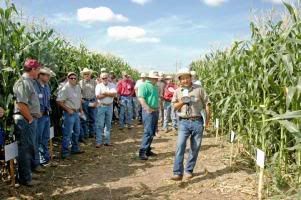Researchers develop drought-tolerant corn varieties

With the continuing decline of the water level at one of the world's largest aquifers - the Ogallala Aquifer which is located beneath the Great Plains in the U.S. - and with increasing cost of pumping water, the use of drought-tolerant and high-yield corn hybrids is a key for sustainable corn production under limited irrigation, the breeder says.
The researchers hope to reduce the amount of water required for corn by at least 10 percent, which would make a serious difference on water withdrawal rates.
A field day was held recently at the North Plains AgriLife Research Station near Etter to demonstrate the differences between the parent plants and the offspring, or crosses.
Already the AgriLife Research program out of Lubbock has released four inbred lines of corn and numerous others are in the process for release.
The new multiple-stress-tolerant corn lines can be used to produce corn hybrids adapted to Texas and other southern states. They can be a powerful tool to save water and produce crops with yield and grain quality under stressful environments. - Dr. Wenwei Xu, breeder at AgriLife ResearchThe research station at Etter is one of three test sites in Xu's program. The others are located at Halfway and Lubbock. About 500 hybrids are being evaluated this year for either grain yield or silage yield and quality.
Xu said there has been an increasing demand for silage corn in the Texas High Plains, and producers need new hybrids adapted to the local environment. Corn produced in the U.S. is primarily based on two races of maize, but there are more than 250 races identified around the world:
Most of our breeding efforts start by crossing tropical corn with temperate elite lines. Then we select for desirable traits to broaden genetic diversity and introduce useful genes from exotic corn to improve stress tolerance, agronomic productivity, disease resistance, insect resistance and value-added grain characteristics. - Dr. Wenwei XuXu said some of the experimental hybrids they are working with have produced the same silage yield under irrigation equaling 75 percent evapotranspiration as with 100 percent evapotranspiration irrigation.
Evapotranspiration is the loss of water from the soil both by evaporation and by transpiration from the plants, and is reported on a daily basis through the Texas High Plains Evapotranspiration Network:
 energy :: sustainability :: biomass :: bioenergy :: biofuels :: corn :: maize :: water :: irrigation :: crop breeding :: hybrid :: drought-tolerance ::
energy :: sustainability :: biomass :: bioenergy :: biofuels :: corn :: maize :: water :: irrigation :: crop breeding :: hybrid :: drought-tolerance :: Bruce Spinhirne, AgriLife Research associate based in Lubbock, said they reduced the irrigation on a few hybrids by 50 percent and had a severe yield and quality limitation, so they followed that by the 75 percent water application.
Those results are due in part to the use of stored moisture in the soil profile, Spinhirne says. At 75 percent (evapotranspiration), you have 3 to 4 inches of available moisture that is used, where if you are watering at 100 percent, it is wasted, the researcher adds.
The average silage yield of 20 corn hybrids at two locations (Etter and Halfway) was 26.84 tons per acre under 75 percent evapotranspiration irrigation, just slightly lower than the 27.49 tons per acre under 100 percent evapotranpiration irrigation, Spinhirne said.
However there were significant differences among hybrids in each environment. One of the experimental hybrids produced the same amount of silage in both locations when irrigation was reduced from 100 percent to 75 percent.
The researchers think that developing and using new corn hybrids with improved tolerance to drought and other stresses is important and a viable water-saving approach.
References:
Wenwei Xu, Bruce Spinhirne, Thomas Marek, Brent Bean, and Dennis Pietsch. Silage Corn Hybrids for the Texas High Plains [*.pdf], Texas Agricultural Experiment Station.
2007 State Silage Corn Performance Test at Etter [*.pdf].
AgriLife Research: AgriLife Research breeder develops drought-tolerant corn - August 22, 2008.
More information on the corn and silage trials can be found here.
 --------------
--------------
 Mongabay, a leading resource for news and perspectives on environmental and conservation issues related to the tropics, has launched Tropical Conservation Science - a new, open access academic e-journal. It will cover a wide variety of scientific and social studies on tropical ecosystems, their biodiversity and the threats posed to them.
Mongabay, a leading resource for news and perspectives on environmental and conservation issues related to the tropics, has launched Tropical Conservation Science - a new, open access academic e-journal. It will cover a wide variety of scientific and social studies on tropical ecosystems, their biodiversity and the threats posed to them.









0 Comments:
Post a Comment
Links to this post:
Create a Link
<< Home